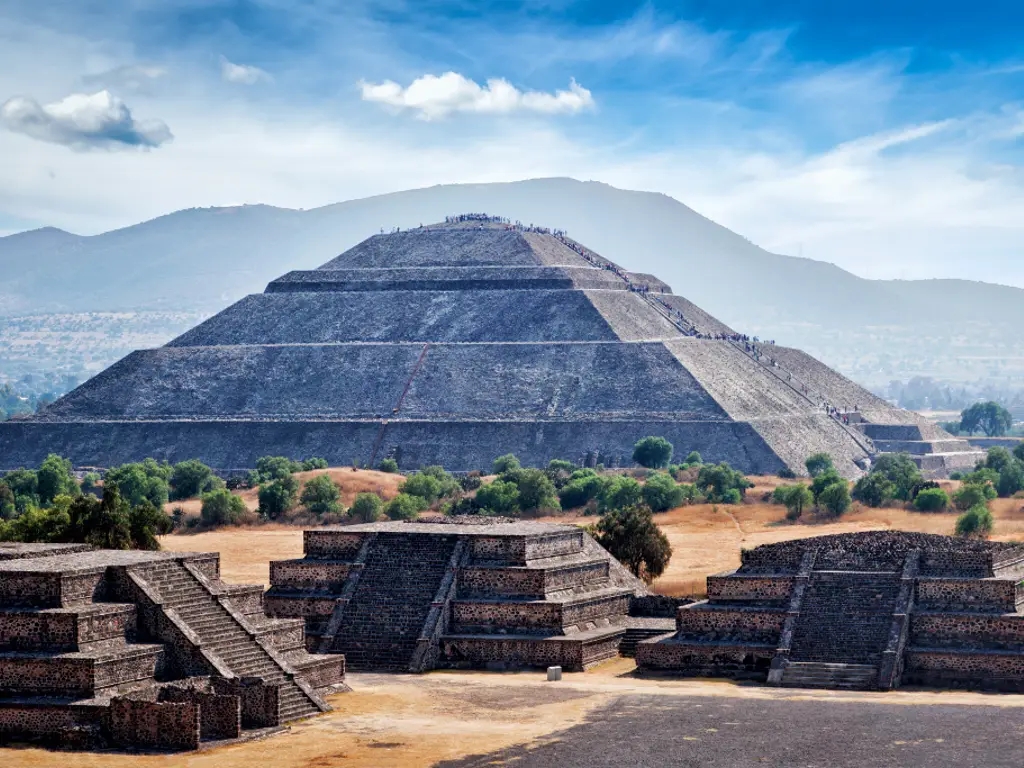
Mexico City Itinerary: 2, 3, or 5 Days
Table of Contents
Mexico City, the delicious and hectic Latin behemoth, can seem impossible to penetrate. With more than 573 square miles to explore, many visitors feel overwhelmed at the daunting task of creating an itinerary. There are tons of neighborhoods and hundreds more museums within them, endless celebrations and festivals, thousands of restaurants and bars, and countless parks. There are ancient pyramids and colonial churches, modern-day malls and venues. Mexico City offers a lot, and there is, in fact, a wise approach for any length of stay in this metropolis of more than 30 million people.

2-day Mexico City itinerary
Day 1: Centro Histórico and Templo Mayor

Start your day with chilaquiles and a coffee at Café La Habana, a timeless diner that was a meeting place for Fidel Castro and Che Guevara, leaders of the Cuban revolution. (Surprisingly enough, the revolution was in part plotted in Mexico.) Then walk across the lovely Alameda Central park, adjacent to the Palacio de Bellas Artes fine arts museum, one of the most prominent and recognizable buildings in the capital characterized by a roof of iron and yellow and orange glass; stop in to see murals by Diego Rivera, José Clemente Orozco, and David Alfaro Siqueiros.

Head just a few blocks to Templo Mayor, the tumbled ruins of the once-dominating Aztec (Mexica) empire. An extensive underground museum accompanies the archeological site and hosts 14,000 indigenous artifacts from around the Valley of Mexico, with specific focus on Tenochitlán (modern-day Mexico City).
For lunch, order carne asada tacos at Yeshua, a classic taquería loved by locals, followed by a Campari or tequila (or Campari and tequila) cocktail at Salon Opera, a bar opened in 1876 where your bartender will gladly show you the bullet holes that Mexican revolutionary Pancho Villa is rumored to have left in the ceiling more than a century ago.
Later, visit Museo de Arte Popular where, as the name suggests, you can view popular artwork from across Mexico. There is a major focus on Indigenous handicrafts that are regional and historic in nature. Be amazed by the colors and designs, and learn a thing or two about ancient and modern Mexico in the process.

Once the evening rolls in, watch the sunset over Mexico City's Centro Histórico—with a mezcal cocktail in hand—at Terraza Catedral. Sample various authentic Mexican delicacies (like tamales and guacamole with fried grasshoppers) with dinner on the patio of Azul Histórico. And as the hustle and bustle of the city center begins to rest for the evening, wander about for mezcal-centric drinks at hip, new mezcalerías, like El Bósforo, La Botica Centro, and La Mudana.
Day 2: Teotihuacán and the Romas
Start your day off with Mexican pastries and cafe con leche at Panadería Rosetta in Roma Norte (and you might want to grab a sandwich or cookies for the road).

Hail an Uber and head to the Teotihuacán pyramids, an ancient Mesoamerican city located about 30 miles northeast of Mexico City. (Note that the trip from the Roma neighborhoods to the pyramids takes about one hour. Try to leave before 7am to avoid as much traffic as possible; after that, you’ll experience some extreme congestion.)
Hire a certified English-speaking guide at the gate to tour Teotihuacán, or explore the ruins yourself. The area around the pyramids was first settled around 400 BC, with construction on the pyramids beginning about 500 years later. The site was founded by the mysterious Teotihuacano people who are said to have disappeared off the face of the earth; the city was later found by the Aztecs and used as a trading site that connected all of Mesoamerica. Teotihuacán was designated a UNESCO World Heritage Site in 1987 for artistic achievements in its construction and the ancient city’s influence as a cultural and ceremonial center.
For lunch, stop by a nearby restaurant: La Gruta serves excellent Mexican cuisine and drinks by candlelight in a cave, and Clotilde has arrabiata pasta with mezcal sauce and refreshing mocktails and cocktails.

Then it’s time to head back to Mexico City’s Roma neighborhoods for the evening; an Uber back to the capital around 4pm shouldn’t take long—about an hour or so—but build in a buffer just in case.
Kick your feet up at your accommodations, or keep moving and save the crash for later. Roma Norte and Roma Sur are filled with incredible souvenir shops, as well as one-of-a-kind clothing boutiques, ceramic outposts, and other retailers. Check out the hand-printed journals at Casa Taller Int 4; Avocet Jewelry, featuring designs based on Mesoamerican cosmology; Under the Volcano Books in nearby Condesa; and the array of hip, unique artisan offerings at Bazar Fusion in Colonia Juárez.
Wind down your day with a cocktail at Hanky Panky or Lucerna in Colonia Juárez. Then cap it off with a laid-back, communal food hall dinner experience at either Lucerna Comedor or Mercado Roma, where you’ll find stalls for whatever you’re craving, whether that’s tacos or Argentine chorizo.
3-day Mexico City Itinerary
Day 3: Coyoacán and Xochimilco
Start the morning with a leisurely stroll through the beautiful, historic neighborhood of Coyoacán. Head to Avellaneda Café, a cute but tiny local-favorite with pastries, Mexican coffee, and hot chocolate.

Visit Frida Kahlo’s Casa Azul, where she spent most of her life; get a glimpse into her life’s work, as well as the way locals lived back when Coyoacán was a separate village, before it became annexed by Mexico City. Tickets should be purchased at least two weeks in advance, as it’s one of the most popular museums in the city.

Next, head to Coyoacán Market and Centenario Street, where you’ll find street vendors and shops selling Mexican handicrafts, mezcal and tequila tastings, and countless eateries at which to stop for a snack.

Grab an Uber to Embarcadero Nuevo Nativitas in Xochimilco for a trajinera tour of the canals left behind by the Aztecs’ sprawling water transport system. See the chinampas—floating islands invented for irrigation and year-round farming. For a small fee, you can pay boats of mariachis to play a few songs or buy beer and esquites (marinated corn with spices) for the duration of your hour-long ride. Note that, here, you shouldn’t need to haggle, as prices for boat tours at this location are standard—which is not always the case at other launch sites.
Visit Diego Rivera’s visionary Anahuacalli Museum, which exhibits his many pilferings of indigenous artifacts in a volcanic-rock building that he commissioned to resemble the pyramids. Entrance is free with your Frida Kahlo ticket, though this museum is much less visited than the former. Wander around the neighborhood a bit, with a stop at an abarrotes (corner store) for a cold drink or snack.
Return to central Coyoacán via bus or rideshare, and visit Museo de Cultura Popular, a small but potent museum that rotates its exhibits to give visitors a greater understanding of the cultural richness of the entire republic. This museum hosts festivals dedicated to tamales and cacao, as well as exhibits featuring incredible artistic expressions, from mask-making to photography and ceramics.
A staple of Coyoacán is the al pastor (marinated pork) tacos at Pepe Coyotes. Pair them with a beer or some agua fresca (fresh fruit water), and watch as night descends on the city.
Wrap up your day with a stroll through Coyoacán’s center and a cocktail at famed cantina La Coyoacana or mezcalería El Mezcalero. On busier nights—Thursdays through Sundays—the center park of Coyoacán fills with street vendors and performers, all promising plenty of entertainment; expect clowns juggling machetes, children’s theater, musicians, and poets who will pen you a personalized poem.
5-day Mexico City Itinerary
Day 4: Chapultepec Park and the National Anthropology Museum

Visit Antonieta Pan y Café for fresh pastries, coffee, and other nourishing breakfast options on the edge of the beautiful, nearly-1,700-acre Chapultepec Park, not far from Roma Norte. It's a great opportunity to enjoy the morning sun before it gets too hot.
Stop by El Castillo, a (literal) castle located in the park that houses a strange history of self-proclaimed European leaders of Mexico and gives a glimpse into New World opulence of the mid-19th century. Bonus: It has one of the best views of the park and central Mexico City.
Head over to the National Anthropology Museum, and enjoy lunch at the museum’s restaurant—which offers steak, quesadillas, sandwiches, and snacks—before exploring the world-class collection. (Museum restaurants aren’t typically anything to write home about, but this one has tasty options, and considering you may spend the better part of your day here, it’s a solid option for some mid-day fuel.) Seeing everything at the museum would take days—but three hours is a solid start. Start with the rooms dedicated to Tenochtitlán, including the display of the famed “Aztec Calendar,” and the Mayan rooms.

Make your way to the posh neighborhood of Polanco for pre-dinner cocktails. The tequila drinks and variety of mezcals at Limantour receive an honorable mention. Then treat yourself to a luxurious dinner at Animal Masaryk, where seafood—including a Mexican take on Japanese omakase—is the speciality. After dinner, take a stroll through the nearby leafy Condesa neighborhood, where cocktails (like Salón Malafama and Deleted Souls) and post-dinner coffee options (like Perfida and Chiquitito) abound.
Day 5: Day trip to Tepoztlán

It’s impossible to get to know a place like Mexico City in four short days, but the surrounding region is visit-worthy in its own right. So if you feel like escaping the capital buzz for a bit, head to the bohemian mountain village of Tepoztlán. Take the ADO bus from Mexico City’s Tasqueña terminal to Tepoztlán. Catch a taxi to the center, and stop for breakfast along the main strip—El Rincón del Itacate is where you'll find the famous local delicacy, itacate—triangular corn masa topped with meat, cheese, or veggies.
Walk to the end of the main road and head straight up on about a 45-minute hike to El Tepozteco, a thousand-year-old pyramid dedicated to the Aztec god of Pulque that historically attracted pilgrims from countries far and wide.
Book a mid-day temazcal sweat lodge experience at Uitetl Nantli Tlali; this intense yet beautiful Indigenous practice is recognized for its ample health benefits, such as stress relief and detoxing the organs, and is best when followed by a massage.
Enjoy a leisurely lunch with a spectacular view of downtown Tepoztlán at El Ciruelo, with specialties such as squash carpaccio and chicken stuffed with corn mushrooms, and after that, peruse what the street vendors and shops are selling along the central streets of Tepoztlán.
In the evening, grab a coffee and decompress on the open-air patio at Alquimista Café-Bótica before making your way back to the city.
Key Mexico City Travel Details
Where to stay in Mexico City

There are 16 boroughs (delegaciones) that make up Mexico City. The most centrally located of the boroughs will allow you to experience the most touristic and cultural offerings, like museums and concert halls. Off-the-beaten path boroughs—such as Tlalpan, Milpa Alta, and Tlahuac—are interesting but more remote and farther from the activities that most people want to engage with on their first trip to CDMX.
Roma Sur and Roma Norte
The Roma neighborhoods are among the best located in the city, with easy access to the city center and not far from Coyoacán. These neighborhoods also are rich with cultural offerings, like music venues, bars and restaurants, theaters and markets, making them a great place from which to settle in and experience CDMX.
Santa Maria de la Ribera
Just northwest of the city center and close to the bustling neighborhoods of Juárez, the Romas, and Condesa, Santa Maria de la Ribera offers a less-touristed but very livable experience of the city. It’s affordable and a unique place to wander around, boasting unique architecture, parks, cantinas, and restaurants.
Centro Histórico
Mexico City’s official center is located around a large square, known as the Zócalo. CDMX is a living history museum and the greatest city in which to experience the beginning of the “New World”: Within the same block radius, you’ll find a pre-Columbian archeological site (this was the location of Tenochtitlán, the capital of the great Aztec Empire), Spanish churches from the 16th century, and modern stores.
Coyoacán
Second only to Centro Histórico in terms of historical significance, Coyoacán is on the southern side of the city, a leafy borough with parks and colonial architecture, with houses in the center of Coyoacán dating back to the 16th century, including one that belonged to Hernán Cortés, the lead Spanish invader. With museums, music venues, mezcalerías, bars, open-air cafés, shops, and markets, it’s a charming and walkable neighborhood.
Benito Juárez
In the geographic center of the city, Benito Juaréz is made up of several smaller neighborhoods, called colonias, that are pleasant from which to base your stay. It’s mostly a residential borough, with some business centers and many mom-and-pop shops and cafés. Public transport is easy to come by here, and walking and biking are pleasant.
Rooms in Mexico City have quite a range from $40-$400 or so, but most travelers from the US will still consider it a bargain, as a 4-star experience can be found in a $100 room. Hotel MX Zócalo runs $44 per night, with great views of the city center, whereas La Valise in Roma is a boutique hotel that runs $400 per night. Mid-range hotels like Geneve ($80) and Gran Hotel Ciudad de México ($160) offer splendid appeal in fun neighborhoods.
How to get around Mexico City
In general, Mexico City is pretty walkable within neighborhoods and between adjacent neighborhoods; however, the city is sprawling. So where walking won’t work, public transport, bikes, and rideshares fill in the gaps. Just remember that the capital is home to more than 22 million people, and traffic is common. Rush hour typically hits 7–10am and 5:30–8:30pm; you’ll also get another rush hour around 2–4pm when schools let out and people head out for lunch. Public transport during these hours is particularly crowded, and pickpockets are unfortunately common. Women should note that there are subway and metro cars specifically for women and children, which makes for a more comfortable experience. On Saturdays, you can expect congestion all day, from about 9am–8pm.
The bus system can be a bit confusing, as stops are not well-documented, and vehicles are sporadic in their arrival times—but it can be a fun challenge if you’re working on your Spanish! Buses cost 5-7 pesos (about 35 cents) to ride, depending on the distance. The metro is one of the best ways to get around and also the cheapest. It can take you to most parts of the city that tourists visit, but it will not take you all the way to Teotihuacán or the southernmost borough of Milpa Alta. Additionally, the metrobus is a decent way to get around on the main thoroughfares but gets impossibly crowded during peak hours.
When to go to Mexico City

Mexico City is most pleasant during the late summer (August–October), early fall, and winter (January–February). Temperatures April through June can soar into the upper-80s, which can feel very hot with so much development, and at the tail end of the dry season, smog levels can make travel very uncomfortable. Winter months are cool but rain-free; heavy rains fall in July and August but usually only for a few hours per day (just in time to complicate the evening commute).
Many local families leave the city for summer vacation in July and August, as well as at Christmas, New Year, and Easter, so there is generally less traffic; however, more visitors from other regions of Mexico tend to flock to the capital. The Day of the Dead has become a popular holiday for tourism, with celebrations occurring on and around November 1–2. Each neighborhood has a patron saint, each saint corresponding with its own day; while those celebrations can be fun to experience, remember that they get extremely crowded and rates surge throughout the city.
See Going's deals on flights to Mexico City, and join today to get cheap flights from all over the world delivered right to your inbox.
Other Mexico City guides
- The Travel Guide to Mexico City
- The Layover Guide to Mexico City
- Mexico City: The Mexican Capital with 150+ Museums—and Almost As Many Types of Tacos
- Where To Stay in Mexico City
- Day Trips From Mexico City
- 15 of the Best Things To Do in Mexico City
- Xochimilco: The Venice of Mexico Where Gondolas Meet Mariachis
Published November 29, 2023
Last updated December 21, 2023
Articles you might like
View AllTreat your travel to cheap flights
Most deals are 40-90% off normal prices with great itineraries from the best airlines. If it's not an amazing deal, we won't send it. Sign up for free to start getting flight alerts.




